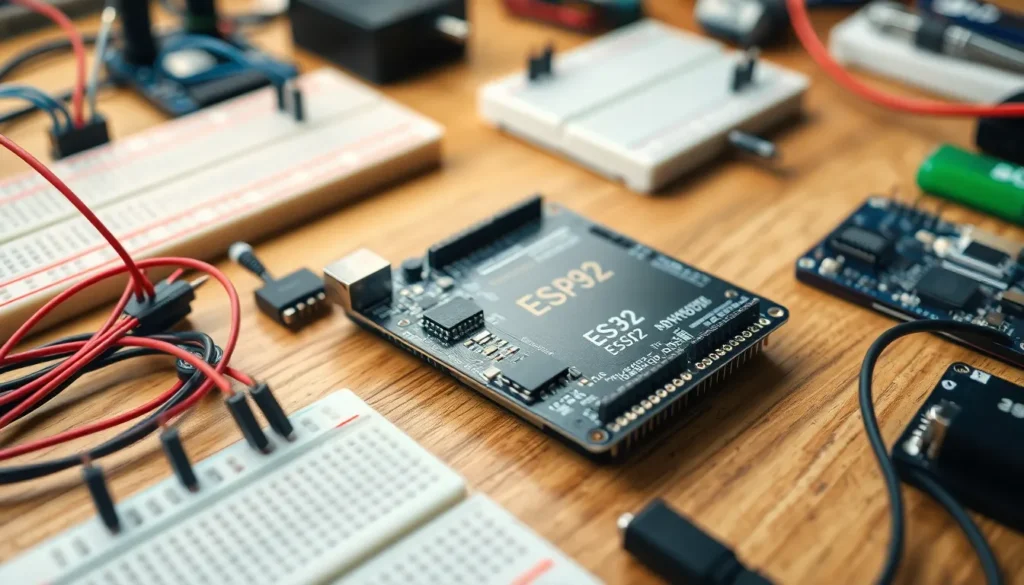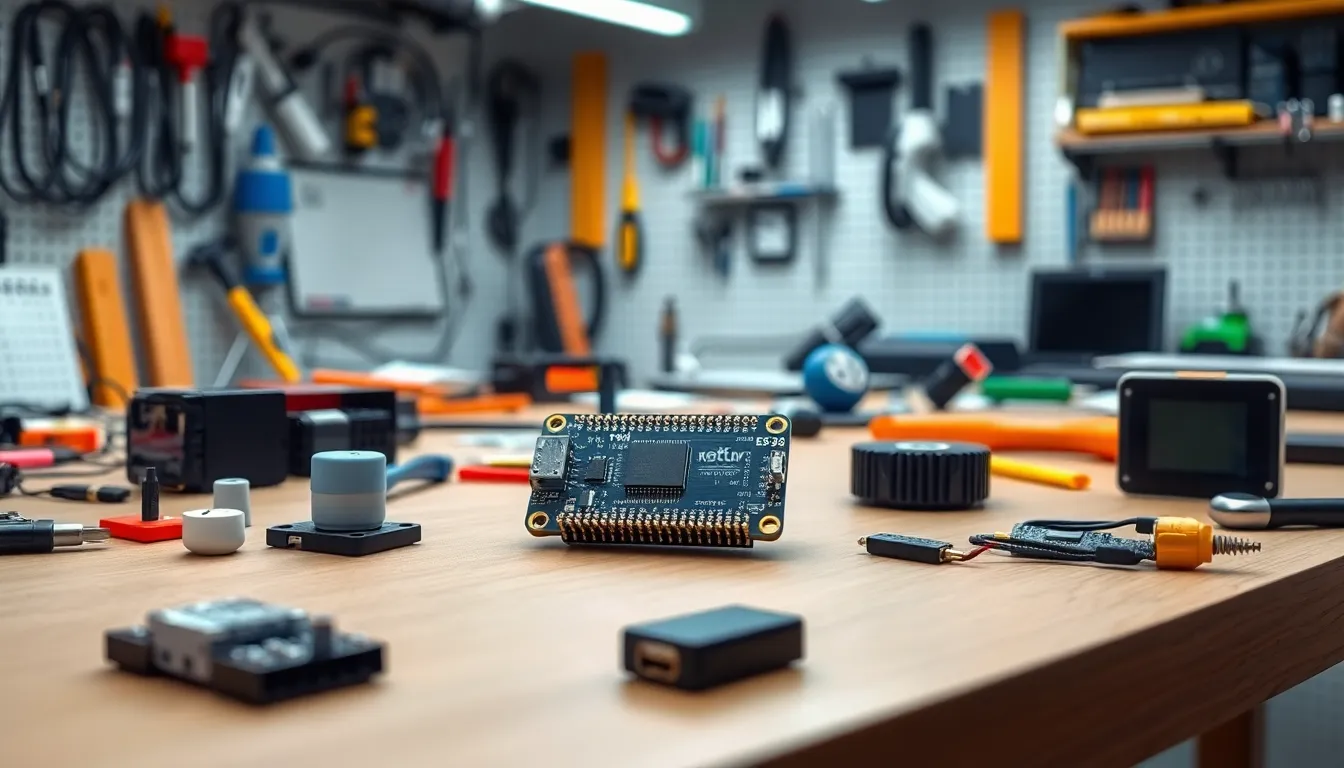Table of Contents
ToggleIn a world where everything seems to be getting smarter, the ESP32 IoT is the secret sauce that transforms ordinary devices into extraordinary gadgets. Imagine a tiny chip that packs a punch, allowing everyday objects to chat with each other and the internet like they’re old pals. Whether it’s turning your home into a smart haven or creating the next big thing in tech, the ESP32 is the go-to choice for innovators and tinkerers alike.
Overview of ESP32 IoT
ESP32 IoT represents a significant advancement in connectivity and processing power. This dual-core microcontroller supports Wi-Fi and Bluetooth, making it ideal for diverse IoT applications. Developers appreciate its versatility in transforming standard devices into intelligent systems.
Various features enhance the ESP32’s functionality. It supports multiple input and output interfaces, including GPIO, ADC, I2C, SPI, and PWM. Each interface allows for seamless integration with sensors and actuators, facilitating the creation of complex projects.
Specific use cases demonstrate the chip’s impact. Smart home systems can utilize ESP32 for remote control and automation of lighting, security, and temperature. Industries leverage the technology for data collection and environmental monitoring in agriculture or manufacturing processes.
Significant memory capacity enables the execution of demanding applications. With 520 KB of SRAM and up to 16 MB of flash storage, developers can run extensive code and store substantial data.
Community support further drives innovation with ESP32. A vast user base shares libraries, projects, and troubleshooting tips online. This collaborative environment accelerates development and enhances learning for newcomers.
Power management features extend the device’s functionality. Low-power modes provide energy efficiency suitable for battery-operated devices. Therefore, applications requiring prolonged battery life benefit from these settings.
Leveraging ESP32 also leads to reduced costs in projects. Integrating multiple functions into one chip means fewer components are needed in a design, lowering material expenses. Economical solutions attract startups and hobbyists pursuing IoT applications.
The potential of ESP32 IoT lies in its capability to bridge the gap between the physical and digital worlds. With its extensive functionalities and community resources, creating innovative and practical IoT solutions becomes increasingly achievable.
Key Features of ESP32
The ESP32 boasts several key features that make it a standout choice for IoT applications. These attributes enhance its functionality, making it an ideal chip for various projects.
Dual-Core Processor
A dual-core processor powers the ESP32, allowing it to handle multiple tasks simultaneously. With a clock speed of up to 240 MHz, the chip efficiently processes complex operations. This architecture supports smooth performance for demanding applications, ensuring responsiveness in real-time scenarios. Developers appreciate this capability, as it enables seamless multitasking across various IoT applications.
Wi-Fi and Bluetooth Capabilities
Wi-Fi and Bluetooth capabilities distinguish the ESP32 in IoT. The chip supports a wide range of connectivity options, including 802.11 b/g/n for Wi-Fi and Bluetooth 4.2. This extensive range allows devices to communicate with each other and to connect to the internet with ease. Consequently, it emerges as an excellent choice for smart home devices and wearables, with many applications leveraging its robust wireless features.
Low Power Consumption
Energy efficiency represents a significant advantage of the ESP32. Its low power consumption makes it suitable for battery-operated devices that require extended operation between charges. In deep sleep mode, the chip consumes as little as 10 µA, dramatically extending battery life. This energy-saving attribute is appealing for projects where power limits matter, ensuring devices function reliably over time.
Getting Started with ESP32 IoT
Understanding the necessary components and setting up the development environment mark the first steps in exploring ESP32 IoT projects.
Required Components
To start with ESP32 IoT, essential components include the ESP32 development board, USB cable, and computer. Additionally, sensors such as temperature and motion might enhance projects. Breadboards provide a flexible working surface, while jumper wires connect components easily. Programmers often use LEDs to indicate status, making debugging straightforward. Power supplies ensure device operation, with battery options extending portability. Acquiring these components supports efficient project development.
Setting Up the Development Environment
Setting up the development environment involves selecting the right software and libraries. Users commonly choose the Arduino IDE or PlatformIO for their intuitive interfaces. Installing relevant libraries facilitates seamless communication between the ESP32 and sensors or actuators. Connecting the ESP32 board to the computer via USB allows easy uploads of code. Developers often configure the IDE to recognize the ESP32 board by selecting the correct board type from the menu. Verifying the connection ensures a smooth workflow in programming and troubleshooting.
Applications of ESP32 IoT
The ESP32 IoT chip supports a wide range of applications across various domains, from home automation to industrial automation. Its versatility empowers developers and hobbyists to create innovative solutions that enhance everyday life.
Home Automation
Home automation solutions leverage the capabilities of ESP32 IoT for seamless control of lighting, security systems, and environmental monitoring. Users can remotely manage devices through smartphones or voice commands, creating smarter living environments. Many homeowners install sensors to automate actions based on conditions, such as adjusting lights based on occupancy or monitoring security cameras. Integration with voice assistants makes it easier to control appliances, ensuring an efficient and comfortable atmosphere. The ability to connect multiple devices through Wi-Fi contributes to a more interconnected home setup.
Wearable Devices
Wearable devices benefit significantly from the compact design and power efficiency of ESP32 IoT. Health monitoring applications, such as fitness trackers and smartwatches, utilize the chip’s Bluetooth capabilities to sync data with smartphones. Users gain insights into their physical activity, heart rate, and sleep patterns through real-time data analysis. Developers also create devices like smart glasses, which integrate augmented reality features. These wearable technologies enhance user experience by providing immediate access to information and notifications, all while promoting an active lifestyle.
Industrial Automation
Industrial automation employs ESP32 IoT chips to improve efficiency and streamline processes in manufacturing environments. Factories utilize the chip for data collection, equipment monitoring, and predictive maintenance. By integrating sensors, companies can track machine performance and identify potential issues before they lead to costly downtime. Remote diagnostics facilitated by ESP32 technology enable engineers to access data from anywhere, enhancing responsiveness. The chip’s ability to operate under varying conditions makes it suitable for different industrial applications, ensuring consistent performance and reliability.
Challenges and Limitations
Despite its capabilities, the ESP32 IoT faces several challenges and limitations. Its dual-core processor, while powerful, can lead to increased power consumption during intensive tasks. Energy efficiency becomes critical in battery-operated projects, requiring careful management of processing loads.
Memory constraints also pose limitations. The ESP32 comes with 520 KB of SRAM, which may not suffice for complex applications involving extensive data processing. Developers must optimize memory usage to ensure smooth operation, especially in data-heavy scenarios.
Interference issues arise due to the chip’s reliance on Wi-Fi and Bluetooth connectivity. In environments with numerous devices, signal overlap can disrupt communication, leading to performance degradation. Addressing these challenges often involves strategic placement of devices and efficient use of networking protocols.
Security concerns exist for IoT devices, including those built with the ESP32. Vulnerabilities in communication channels or improper handling of sensitive information can expose systems to risks. Implementing secure coding practices and utilizing encryption methods becomes essential to safeguard data.
Integration with other hardware components can also present hurdles. Although the ESP32 supports multiple interfaces like GPIO and I2C, compatibility issues might arise with certain sensors or actuators. This necessitates thorough research and testing to ensure seamless integration in projects.
Cost challenges may arise, especially for startups and hobbyists. While the ESP32’s affordability is attractive, additional expenses for components, tools, and platforms can accumulate. Budget planning remains crucial for successful project execution.
Ultimately, addressing these challenges requires strategic foresight, thorough planning, and community collaboration. Developers can mitigate limitations through shared knowledge and innovative solutions, enabling the full utilization of the ESP32 IoT’s potential.
Future Developments in ESP32 IoT
Innovative advancements in ESP32 IoT promise to elevate its capabilities. Enhanced processing power will likely emerge in future iterations, enabling faster data handling and improved multitasking. Improved integration with artificial intelligence (AI) will streamline data analysis, allowing devices to make autonomous decisions based on real-time data.
Expanded memory capacity can accommodate larger applications, facilitating the development of sophisticated IoT solutions. High efficiency in energy consumption features will attract more projects focused on sustainability. Enhanced security protocols will strengthen data protection, addressing growing concerns regarding IoT vulnerabilities.
Further advancements in connectivity options are expected, such as support for newer wireless standards beyond Bluetooth 4.2. These changes can lead to better device interoperability, making communication seamless among various platforms. The influx of 5G technology may optimize the performance of ESP32 devices, enhancing responsiveness in high-demand environments.
Community-driven innovations will continue pushing the boundaries of what can be achieved with the ESP32. As experiences and solutions are shared worldwide, new libraries and tools will emerge, simplifying project development. The growth of the ESP32 ecosystem encourages collaboration among hobbyists, makers, and entrepreneurs, leading to novel applications.
Incorporating edge computing capabilities will also be a game changer for the ESP32. This new feature allows for data processing closer to the source, reducing latency and improving overall system performance. The ongoing evolution of the ESP32 IoT will pave the way for groundbreaking applications, cementing its role as a foundational technology in the smart device landscape.
Conclusion
The ESP32 IoT chip stands at the forefront of innovation in smart technology. Its robust features and versatile applications empower developers to create intelligent systems that enhance everyday life. As the IoT landscape evolves, the ESP32’s potential for integration with emerging technologies like AI and 5G positions it as a key player in future advancements.
Community support continues to drive creativity and problem-solving, making it easier for newcomers to dive into their projects. While challenges exist, strategic planning and collaboration can help overcome obstacles. The ongoing development of the ESP32 IoT ensures it will remain a foundational technology for years to come, inspiring countless innovative solutions in various sectors.





